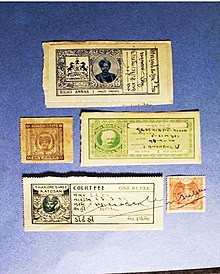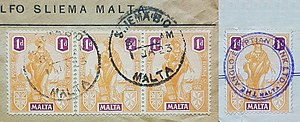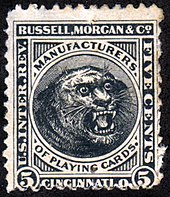
An 1898 £1 revenue stamp of Western Australia

Revenue stamps on smuggled tobacco seized by the British tax authorities.
A revenue stamp, tax stamp, duty stamp or fiscal stamp is a (usually) adhesive label used to designate collected taxes or fees on documents, tobacco, alcoholic drinks, drugs and medicines, playing cards, hunting licenses, firearm registration, and many other things. Typically, businesses purchase the stamps from the government (thereby paying the tax), and attach them to taxed items as part of putting the items on sale, or in the case of documents, as part of filling out the form.
Revenue stamps often look very similar to postage stamps, and in some countries and time periods it has been possible to use postage stamps for revenue purposes, and vice versa. Some countries also issued dual-purpose postage and revenue stamps.

Fiscal stamps of Punadra, Khadal, Ambaliara, Katosan and Jawhar ruled by Koli rulers in India 1947
https://en.wikipedia.org/wiki/Revenue_stamp
Revenue stamps are stamps used to designate collected taxes and fees. They are issued by governments, national and local, and by official bodies of various kinds. They take many forms and may be gummed and ungummed, perforated or imperforate, printed or embossed, and of any size. In many countries, they are as detailed in their design as banknotes; they are often made from the same type of paper. The high value of many revenue stamps means that they may contain security devices to prevent counterfeiting.
The Revenue Society has defined revenue stamps as " ...stamps, whether impressed, adhesive or otherwise, issued by or on behalf of International, National or Local Governments, their Licensees or Agents, and indicate that a tax, duty or fee has been paid or prepaid or that permission has been granted."[1]
https://en.wikipedia.org/wiki/Revenue_stamp
The use of revenue stamps goes back further than that of postage stamps (first used in 1840); the stamps of the Stamp Acts of the 18th century were revenues.[3] Their use became widespread in the 19th century, partly inspired by the success of the postage stamp, and partly motivated by the desire to streamline government operations, the presence of a revenue stamp being an indication that the item in question had already paid the necessary fees. Revenue stamps have become less commonly seen in the 21st century, with the rise of computerization and the ability to use numbers to track payments accurately.

A 1922 Malta 1d stamp from the Melita issue which was valid for both postal and fiscal use. The strip of three on the left was postally used at Sliema, and the single on the right was fiscally used at an Anglo-Egyptian Bank branch
There are a great many kinds of revenue stamps in the world, and it is likely that many remain unrecorded. Both national and local entities have issued them. Governments have sometimes combined the functions of postage and revenue stamps. In the former British Empire, such stamps were often inscribed "Postage and Revenue" to reflect their dual function. Other countries have simply allowed revenue stamps to be used for postage or vice versa. A revenue stamp authorized subsequently for postal use is known as a postal fiscal. Bhutan, for instance, authorized the use of revenue stamps for postal purposes from 1955 until the first proper postage stamps of the country were issued in 1962. In the Stanley Gibbons catalog, this type of stamp has an F prefix.[4]
Methods of cancellationMain article: Fiscal cancel

An American revenue stamp for the tax on playing cards
While revenue stamps often resemble postage stamps, they are not normally intended for use on mail and therefore do not receive a postal cancellation. Some countries such as Great Britain have issued stamps valid for both postage and revenue, but this practice is now rare. Many different methods have been used to cancel revenue stamps, including pen cancels, inked handstamps, perforating, embossing, hole punching or simply tearing.
From around 1900, United States revenue stamps were required to be mutilated by cutting, after being affixed to documents, and in addition to being cancelled in ink. A class of office equipment was created to achieve this which became known as "stamp mutilators".[5][6]
CollectingRevenue stamps were once widely collected by philatelists and given the same status as postage stamps in stamp catalogues and at exhibitions. After World War One, however, they declined in popularity, possibly due to being excluded from catalogues as the number of postage stamps issued rose rapidly and crowded revenues out.
The lowest point in revenue philately was during the middle years of the twentieth century. A Stanley Gibbons children's stamp album from the 1950s warned in its introduction: "Since Philately is the collecting of stamps that are employed in connection with the Posts, do not put in your album fiscals, telegraph stamps, tobacco-tax labels and other such strange things as are often found in some collections."[7] This is not a definition of philately that would be recognised today.
More recently, revenue philately has become popular again and now has its own FIP (Fédération Internationale de Philatélie) Commission and is an approved category in FIP endorsed stamp exhibitions.[8]
Many catalogues have been issued by specialist publishers and dealers but revenue stamps still do not feature in some of the most popular catalogues, for instance by Stanley Gibbons and Michel, unless they are revenue and postage stamps. However, both the standard Scott and the Scott Specialised United States catalogue feature US revenue stamps. The leading catalogue for revenue stamps of the United Kingdom, the British Commonwealth and several European countries is the Barefoot Catalogue.
Some types of revenue stampsMain article: List of types of revenue stamps

1871 U.S. Revenue stamp for 1/6 Barrel of beer
Court feesOne of the earliest uses of revenue stamps was to pay Court Fees. Stamps were used in the Indian feudal states as early as 1797, almost 50 years before the first postal stamps.[9]
Although India is only one of several countries that have used tax stamps on legal documents, it was one of the most prolific users. The practice is almost entirely stopped now, partly due to the prevalence of forgeries which cost the issuing government revenue.[10]
DocumentsThe tax on documents, also commonly known as stamp duty, is one of the oldest uses of revenue stamps, probably being invented in Spain, and introduced (or re-invented) in the Netherlands in the 1620s, then reaching France in 1651 and England in 1694.[11] Governments enforce the payment of the tax by making unstamped documents unenforcable in court. The tax has been applied to contracts, tenancy agreements, wills etc. A pre-printed revenue stamp appeared on many hundis of India.[12]
Tobacco and alcoholIn many countries, tobacco and alcohol are taxed by the use of excise stamps. For instance, the producer may buy stamps from the government which are then affixed to each bottle of alcohol or packet of cigarettes to show that tax has been paid. Often the stamp will be fixed across a seal so that on opening the pack or bottle the stamp is destroyed.[13]
https://en.wikipedia.org/wiki/Revenue_stamp
https://en.wikipedia.org/wiki/Excise_stamp
https://en.wikipedia.org/wiki/Impressed_duty_stamp
https://en.wikipedia.org/wiki/Postal_tax_stamp
https://en.wikipedia.org/wiki/Stamped_paper
https://en.wikipedia.org/wiki/Turner_Collection_of_Newspaper_Tax_Stamps
https://en.wikipedia.org/wiki/War_tax_stamp
https://en.wikipedia.org/wiki/Property_tax
Trade
CustomDutyTariff ImportExportTariff warFree tradeFree-trade zoneTrade agreementATA Carnet
https://en.wikipedia.org/wiki/Property_tax
Trade
CustomDutyTariff ImportExportTariff warFree tradeFree-trade zoneTrade agreementATA Carne
International
A per unit tax, or specific tax, is a tax that is defined as a fixed amount for each unit of a good or service sold, such as cents per kilogram. It is thus proportional to the particular quantity of a product sold, regardless of its price. Excise taxes, for instance, fall into this tax category. By contrast, an ad valorem tax is a charge based on a fixed percentage of the product value. Per unit taxes have administrative advantages when it is easy to measure quantities of the product or service being sold.
https://en.wikipedia.org/wiki/Per_unit_tax
https://en.wikipedia.org/wiki/Watermark
Category:Philatelic terminology
This category exists to capture articles about the terminology of philately.
Subcategories
This category has only the following subcategory.
C
- Commemorative stamps (1 C, 13 P)
Pages in category "Philatelic terminology"
The following 200 pages are in this category, out of approximately 240 total. This list may not reflect recent changes.
(previous page) (next page)A
B
C
- Cachet
- Cancellation (mail)
- Cancelled-to-order
- Carrier's stamp
- Catcher pouch
- Centro de hoja
- Chalky paper
- Charity label
- Christmas seal
- Christmas stamp
- Cinderella stamp
- Classic stamp
- Coded postal obliterators
- Coil stamp
- Coil waste
- Combination cover (philately)
- Conjunctive use (philately)
- Corner card
- Country definitives
- Courtesy reply mail
- Cover (philately)
- Crash cover
- Cut-out (philately)
D
E
F
I
L
M
P
- Parcel post
- Parcel stamp
- Paste-up pair
- Pen cancel
- Penny Penates
- Perfin
- Perforation gauge
- Personalised stamp
- Philatelic auction
- Philatelic bureau
- Philatelic calendar
- Philatelic cover
- Philatelic fakes and forgeries
- Phonopost
- Phosphor banded stamp
- PHQ card
- Plate block
- Plate number
- Plate number coil
- Plating (philately)
- Pony Express mochila
- Postage and revenue stamp
- Postage due
- Postage stamp
- Postage stamp block
- Postage stamp booklet
- Postage stamp color
- Postage stamp demonetization
- Postage stamp design
- Postage stamp design error
- Postage stamp gum
- Postage stamp reprint
- Postage stamp separation
- Postal card
- Postal fiscal stamp
- Postal history
- Postal marking
- Postal stationery
- Postal tax stamp
- Postcard
- Poste restante
- Poster stamp
- Postmark
- Pre-adhesive mail
- Precancel
- Presentation pack
- Primitive (philately)
- Printed matter
- Printer's sample stamp
- Private cancellation
- Private Mail Bag
- Private overprint
- Pro Juventute
- Proof (philately)
- Provisional stamp
- Pull (philately)

No comments:
Post a Comment